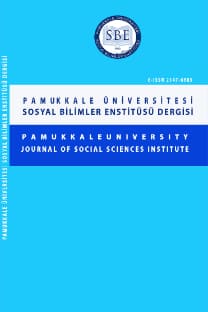A SHAWL TO REMEMBER: CYNTHIA OZICK'S NARRATIVE AGAINST FOR GETTING IN THE SHA WL
HATIRLANMASI GEREKEN BIR ŞAL: THE SHAWL DA CYTHNIA OZICK IN UNUTMAYA KARŞI KULLANDIĞI ANLATIM
___
- Berger, A. L. and Cronin, G. (2004). Jewish American and Holocaust Literature: Representation in the Postmodern World, State University of New York Press, Albany.
- Budick, M. E. (2003). The Holocaust in the Jewish American Literary Imagination, The Cambridge Companion to Jewish American Literature, (Ed. M. P. Kramer and H. Wirth- Nesher), Cambridge University Press, Cambridge.
- Freud, S. (1922, rpt. 2006). Beyond the Pleasure Principle, The Penguin Freud Reader, (Ed. A. Phillips), Penguin, London.
- ---. (1917). Mourning and Melancholia
- ---. (1914). Remembering, Repeating, and Working Through Horowitz, S. R. (1997). Voicing the Void: Muteness and Memory in Holocaust Fiction, State University of New York Press, Albany.
- Kauvar, E. M. (1993). Cynthia Ozicks Fiction: Tradition& Invention, Indiana University Press, Bloomington and Indianapolis.
- Kremer, S. L. (1999). Womens Holocaust Writing: Memory and Imagintion, University of Nebraska Press, Lincoln and London.1999.
- Kristeva, J. (1987). Black Sun: Depression and Melancholia, Colombia University Press, New York and Oxford.
- LaCapra, D. (1998). History and Memory After Auschwitz, Cornell University Press, Ithaca and London.
- --- (1994). History, Theory, Trauma: Representing the Holocaust, Cornell University Press, Ithaca and London.
- --- (1999). Trauma, Absence, Loss. Critical Inquiry, 25.4, 696- 727.
- Langer, L. (1994). Remembering Survival, Holocaust Remembrance: The Shapes of Memory, (Ed. G. H. Hartman), Blackwell, Oxford and Cambridge.
- Lifton, R. J. (1926). The Nazi Doctors: Medical Killing and the Psychology of Genocide, Basic Books, New York.
- Ozick, C. (1990). The Shawl, Vintage, New York.
- Postman, N. (1989). Learning by Story, Atlantic Monthly, 121- 124.
- Prose, F. Interview with Cynthia Ozick. New York Times Book Review. September 10, 1989.
- Rosen, N. (1987). Second Life of Holocaust Imagery. Midstream, April 1987.
- Rosenfield, A. H. (1980). A Double Dying: Reflections and Holocaust Literature, Indiana University Press, Bloomington.
- Sivan, M. (2009). Belonging Too Well: Portraits of Identity in Cynthia Ozicks Fiction, State University of New York Press, Albany.
- Statlander, J. (2002). Cultural Dialectic: Ludwig Lewisohn and Cynthia Ozick, Peter Lang Publishing, Oxford.
- Yerushalmi, Y. H.(1982). Zakhor, Jewish History and Jewish Memory, University of Washington Press, Seattle.
- ISSN: 1308-2922
- Yayın Aralığı: 6
- Başlangıç: 2008
- Yayıncı: Pamukkale Üniversitesi
KARL POPPER'IN YÖNTEMİNDE HİPOTETİK-DEDÜKTİF FORMUN BİLİMSEL İNŞASI
INTERNATIONAL HUMAN RESOURCE MANAGEMENT AND NATIONAL CULTURAL CHALLENGES
WILDE' TIMES: A MARXIST READING OF OSCAR WILDE'S THE HAPPY PRINCE
A SHAWL TO REMEMBER: CYNTHIA OZICK'S NARRATIVE AGAINST FOR GETTING IN THE SHA WL
X. -XVII. YÜZYILLARDA YAKIN VE ORTA DOĞU'DA BİLİMLERİN TASNİFİ TARİHİ
